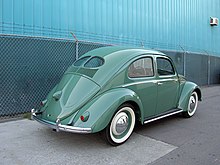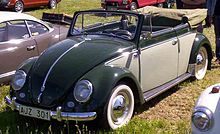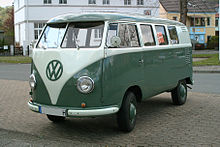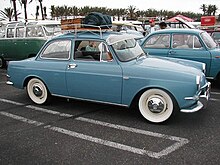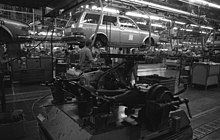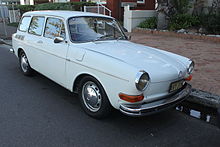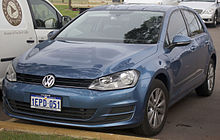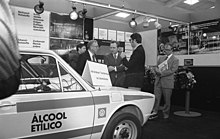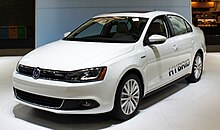Volkswagen
From Wikipedia, the free encyclopedia
"VW" redirects here. For other uses, see VW (disambiguation).
This article is about Volkswagen Passenger Cars. For the parent group, see Volkswagen Group. For Volkswagen vans, trucks and buses, see Volkswagen Commercial Vehicles.
 |
|
| Public | |
| Industry | Automotive |
| Founded | January 4, 1937 |
| Founder | German Labour Front (DAF) |
| Headquarters | Wolfsburg, Germany |
|
Area served
|
Worldwide |
|
Key people
|
Matthias Müller (CEO) |
| Products | Automobile |
|
Production output
|
|
| Revenue | |
| Profit | |
| Total assets | |
|
Number of employees
|
588.9K (2015) |
| Parent | Volkswagen Group |
| Subsidiaries | Volkswagen Commercial Vehicles |
| Slogan | Das Auto. |
| Website | vw.com |
Volkswagen translates as "People's Automobile" in German. The company's current international slogan is "Volkswagen".[2][3] In American English, the pronunciation is approximized as "volks-wagon" (
Contents
History
- For vehicle timeline tables, see: Volkswagen (timeline).
1932–1938: People's Car project
Volkswagen was originally created in 1936 by the German Labour Front (Deutsche Arbeitsfront).[5] In the early 1930s, the German auto industry was still largely composed of luxury models, and the average German could rarely afford anything more than a motorcycle. As a result, only one German out of 50 owned a car. Seeking a potential new market, some car makers began independent "peoples' car" projects – the Mercedes 170H, Adler AutoBahn, Steyr 55, and Hanomag 1.3L, among others.
VW logo during the 1930s, initials surrounded by a stylized cogwheel and swastika wings[6]
In 1932, with many of the above projects still in development or early stages of production, Adolf Hitler got involved, ordering the production of a basic vehicle capable of transporting two adults and three children at 100 km/h (62 mph). He wanted his German citizens to have the same access to a car as the Americans.[8] The "People's Car" would be available to citizens of the Third Reich through a savings plan at 990 Reichsmark ($396 in 1930s U.S. dollars)—about the price of a small motorcycle (the average income being around 32RM a week).[9][10]
Despite heavy lobbying in favour of one of the existing projects, it soon became apparent that private industry could not turn out a car for only 990RM. Thus, Hitler chose to sponsor an all-new, state-owned factory using Ferdinand Porsche's design (with some of Hitler's design constraints, including an air-cooled engine so nothing could freeze). The intention was that ordinary Germans would buy the car by means of a savings scheme ("Fünf Mark die Woche musst du sparen, willst du im eigenen Wagen fahren" – "Five marks a week you must put aside, if you want to drive your own car"), which around 336,000 people eventually paid into. However, the entire project was financially unsound, and only the corruption and lack of accountability of the Nazi regime made it possible.[11][Note 1]
Prototypes of the car called the "KdF-Wagen" (German: Kraft durch Freude – "strength through joy"), appeared from 1938 onwards (the first cars had been produced in Stuttgart). The car already had its distinctive round shape and air-cooled, flat-four, rear-mounted engine. The VW car was just one of many KdF programs, which included things such as tours and outings. The prefix Volks— ("People's") was not just applied to cars, but also to other products in Germany; the "Volksempfänger" radio receiver for instance. On 28 May 1936, the Gesellschaft zur Vorbereitung des Deutschen Volkswagens mbH (sometimes abbreviated to Gezuvor[12]) was established by the Deutsche Arbeitsfront. It was later renamed "Volkswagenwerk GmbH" on 16 September 1937.[13][14]
VW Type 82E
The building of the new factory started 26 May 1938 in the new town of KdF-Stadt (modern-day Wolfsburg), which had been purpose-built for the factory workers.[13] This factory had only produced a handful of cars by the time war started in 1939. None were actually delivered to any holder of the completed saving stamp books, though one Type 1 Cabriolet was presented to Hitler on 20 April 1944 (his 55th birthday).[13]
War changed production to military vehicles—the Type 82 Kübelwagen ("Bucket car") utility vehicle (VW's most common wartime model), and the amphibious Schwimmwagen—manufactured for German forces. As was common with much of the production in Nazi Germany during the war, slave labor was utilized in the Volkswagen plant, e.g. from Arbeitsdorf concentration camp. The company would admit in 1998 that it used 15,000 slaves during the war effort. German historians estimated that 80% of Volkswagen's wartime workforce was slave labor.[citation needed] Many of the slaves were reported to have been supplied from the concentration camps upon request from plant managers. A lawsuit was filed in 1998 by survivors for restitution for the forced labor.[15] Volkswagen would set up a voluntary restitution fund.[16]
Volkswagen factory
1945–1948: British Army intervention, unclear future
The company owes its post-war existence largely to one man, War-time British Army officer Major Ivan Hirst, REME. In April 1945, KdF-Stadt and its heavily bombed factory were captured by the Americans, and subsequently handed over to the British, within whose occupation zone the town and factory fell. The factories were placed under the control of Oldham-born Hirst, by then a civilian Military Governor with the occupying forces. At first, one plan was to use it for military vehicle maintenance, and possibly dismantle and ship it to Britain. Since it had been used for military production, (though not of KdF-Wagens) and had been in Hirst's words, a "political animal" rather than a commercial enterprise — technically making it liable for destruction under the terms of the Potsdam Agreement — the equipment could have been salvaged as war reparations. (Allied dismantling policy changed in late 1946 to mid-1947, though heavy industry continued to be dismantled until 1951.)One of the factory's War-time 'KdF-Wagen' cars had been taken to the factory for repairs and abandoned there. Hirst had it repainted green and demonstrated it to British Army headquarters. Short of light transport, in September 1945 the British Army was persuaded to place a vital order for 20,000 cars. However, production facilities had been massively disrupted, there was a refugee crisis at and around the factory and some parts (such as carburetors) were unavailable. With striking humanity and great engineering and management ingenuity, Hirst and his German assistant Heinrich Nordhoff (who went on to run the Wolfsberg facility after Military Government ended in 1949) helped to stabilize the acute social situation while simultaneously re-establishing production. Hirst, for example, used his fine engineering experience to arrange the manufacture of carburetors, the original producers being effectively 'lost' in the Russian zone.[17] The first few hundred cars went to personnel from the occupying forces, and to the German Post Office. Some British Service personnel were allowed to take their Beetles back to the United Kingdom when they were demobilised.[18]
In 1986, Hirst explained how it was commonly misunderstood that he had run Wolfsburg as a British Army Major. The defeated German staff, he said, were initially sullen and unresponsive, having been conditioned by many years of Nazism and they were sometimes unresponsive to orders. At Nordhoff's suggestion, he sent back to England for his officer's uniform and from then on, had no difficulty in having his instructions followed. Hirst can be seen photographed at Wolfsburg in his uniform, although he was not actually a soldier at the time but a civilian member of the Military Government. The title of 'Major' was sometimes used by someone who had left the Army as a courtesy title. In fact, Hirst chose not to do so.
The post-war Industrial plans for Germany set out rules that governed which industries Germany was allowed to retain. These rules set German car production at a maximum of 10% of 1936 car production.[19] By 1946, the factory produced 1,000 cars a month—a remarkable feat considering it was still in disrepair. Owing to roof and window damage, production had to stop when it rained, and the company had to barter new vehicles for steel for production.
The car and its town changed their Second World War-era names to "Volkswagen" and "Wolfsburg" respectively, and production increased. It was still unclear what was to become of the factory. It was offered to representatives from the American, Australian, British, and French motor industries. Famously, all rejected it. After an inspection of the plant, Sir William Rootes, head of the British Rootes Group, told Hirst the project would fail within two years, and that the car "...is quite unattractive to the average motorcar buyer, is too ugly and too noisy ... If you think you're going to build cars in this place, you're a bloody fool, young man."[citation needed] The official report said "To build the car commercially would be a completely uneconomic enterprise."[20] In an ironic twist of fate, Volkswagen manufactured a locally built version of Rootes's Hillman Avenger in Argentina in the 1980s, long after Rootes had gone bankrupt at the hands of Chrysler in 1978—the Beetle outliving the Avenger by over 30 years.
Ford representatives were equally critical. In March 1948, the British offered the Volkswagen company to Ford, free of charge. Henry Ford II, the son of Edsel Ford, traveled to West Germany for discussions. Heinz Nordhoff was also present, and Ernest Breech, chairman of the board for Ford Motor Company. Henry Ford II looked to Ernest Breech for his opinion, and Breech said, "Mr. Ford, I don't think what we're being offered here is worth a dime!"[8] Ford passed on the offer, leaving Volkswagen to rebuild itself under Nordhoff's leadership.
1948–1961: Icon of post war West German regeneration
1949 Volkswagen "split rear window" Sedan
Volkswagen Cabriolet (1953)
Volkswagen Type 2 (T1)
An original 1300 Deluxe, circa 1966.
In the later 1960s, as worldwide appetite for the Beetle finally began
to diminish, a variety of successor designs were proposed and, in most
cases, rejected by management.
Volkswagens were first exhibited and sold in the United States in 1949, but sold only two units in America that first year. On entry to the U.S. market, the VW was briefly sold as a Victory Wagon. Volkswagen of America was formed in April 1955 to standardise sales and service in the United States. Production of the Type 1 Volkswagen Beetle increased dramatically over the years, the total reaching one million in 1955.
The UK's first official Volkswagen Importer, Colborne Garages of Ripley, Surrey, started with parts for the models brought home by soldiers returning from Germany.[18]
Canadian Motors, Limited brought in Canada's first shipment of Volkswagens on 10 July 1952 (shipping order 143075). The order consisted of 12 vehicles, (3) model 11C, a black, green, and sandcolor (3) 11GS, a chestnut brown and two azure blue, (2) 24A-M51 in red, (1)21A in blue, (1) 23A in blue, (1) 22A beige color, and one ambulance. Volkswagens were seen in Canada for the first time at the Canadian National Exhibition in August 1952 and were accepted enthusiastically. (At least one Type 2 bus from this order still exists, and is currently in France undergoing restoration.) The first shipment for Volkswagen Canada reached Toronto in early December 1952. (At least one Type 1 from this first shipment still exists, and was driven on a nationwide tour for Volkswagen Canada's 60th year of business festivities in 2012.) By 1955, sales were on a basis that warranted the building of the Volkswagen plant on a 32-acre (130,000 m2) site on Scarboro's Golden Mile. To this, a 60,000-square-foot (5,600 m2) building with administration, showrooms, service, repairs and parts, an addition of 60,000-square-foot (5,600 m2) was built in 1957, with storage for $4,000,000 of parts. (See 1959 Canadian Register of Commerce & Industry held in the Western Libraries at the University of Western Ontario, London, Ontario.)
Sales soared—thanks in part to the famous advertising campaigns by New York advertising agency Doyle, Dane Bernbach. Led by art director Helmut Krone, and copywriters Julian Koenig and Bob Levinson, Volkswagen advertisements became as popular as the car, using crisp layouts and witty copy to lure the younger, sophisticated consumers with whom the car became associated. Even though it was almost universally known as the Beetle (or the Bug), it was never officially labelled as such by the manufacturer, instead referred to as the Type 1.
Although the car was becoming outdated, during the 1960s and early 1970s, American exports, innovative advertising, and a growing reputation for reliability helped production figures surpass the levels of the previous record holder, the Ford Model T. On 17 February 1972 the 15,007,034th Beetle was sold. Volkswagen could now claim the world production record for the most-produced, single make of car in history. By 1973, total production was over 16 million.
To commemorate its passing the Ford Model T's record sales mark and its victories in the Baja 1000 Mexican races from 1967 to 1971, Volkswagen produced its first limited-edition Beetle. It was marketed as the "Baja Champion SE"[21] in the United States and the "Marathon" Superbeetle in the rest of the world. It featured unique "Marathon Blau" metallic blue paint, steel-pressed 10-spoke 15-inch (38 cm) magnesium-alloy wheels, a commemorative metal plate mounted on the glovebox and a certificate of authenticity presented to the original purchaser. Dealer-installed options for this limited-edition Superbeetle included the following: white stripes running the length of the rocker-panel, a special shifter knob, bumper overriders, tapered exhaust tips, fake walnut inserts in the dashboard (behind the steering wheel and the glovebox cover) as well as Bosch fog lights mounted on the front bumper.
1961–1973: Beetle to Golf
A 1963 VW Type 3 Notchback
Volkswagen Type 4 assembly line in Wolfsburg as of 1973
1969 VW Squareback (Type III)
By late 1972, Volkswagen had decided to cancel the nearly finished typ 266, a project for a mid-engined car to replace the Beetle, and to focus on front-wheel-drive, water-cooled cars. Rudolf Leiding, recently made head of Volkswagen, cited noise, heat, and servicing problems with the mid-engine layout, as well as the difficulty of making it a station wagon.[23]
Volkswagen Passat (1973–1977 model)
First in the series was the Volkswagen Passat (Dasher in the US), introduced in 1973, a fastback version of the Audi 80, using many identical body and mechanical parts. Estate/wagon versions were available in many markets. In Europe, the estate/wagon version dominated in market share for many years.
In spring 1974, the Scirocco followed. The coupe was designed by Giorgetto Giugiaro. Based on the platform of the not yet released Golf, it was built at Karmann due to capacity constraints at Volkswagen.
The pivotal model emerged as the Volkswagen Golf in 1974, marketed in the United States and Canada as the Rabbit for the 1st generation (1975–1985) and 5th generation (2006–2009). Its angular styling was designed by the Italian Giorgetto Giugiaro). Its design followed trends for small family cars set by the 1959 Mini – the Golf had a transversely mounted, water-cooled engine in the front, driving the front wheels, and had a hatchback, a format that has dominated the market segment ever since. Beetle production at Wolfsburg ended upon the Golf's introduction. It continued in smaller numbers at other German factories (Hanover and Emden) until 1978, but mainstream production shifted to Brazil and Mexico.
In 1975, the Volkswagen Polo followed. It was a re-badged Audi 50, which was soon discontinued in 1978. The Polo became the base of the Volkswagen Derby, which was introduced 1977. The Derby was for all intents and purposes a three-box design of the Polo. After a second model generation, the Derby was discontinued in 1985, although the bodystyle lived on in the form of the polo classic/polo saloon until 1991.
Passat, Scirocco, Golf, and Polo shared many character defining features, as well as parts and engines. They built the basis for Volkswagen's turn-around.
1974–1990: Product line expansion
Volkswagen Polo (1975–1979 model)
In the 1980s, Volkswagen's sales in the United States and Canada fell dramatically, despite the success of models like the Golf elsewhere. The Japanese and the Americans were able to compete with similar products at lower prices. Sales in the United States were 293,595 in 1980, but by 1984 they were down to 177,709.[25] The introduction of the second-generation Golf, GTI and Jetta models helped Volkswagen briefly in North America. Motor Trend named the GTI its Car of the Year for 1985, and Volkswagen rose in the J.D. Power buyer satisfaction ratings to eighth place in 1985, up from 22nd a year earlier.[26] VW's American sales broke 200,000 in 1985 and 1986 before resuming the downward trend from earlier in the decade. Chairman Carl Hahn decided to expand the company elsewhere (mostly in developing countries), and the New Stanton, Pennsylvania factory closed on 14 July 1988.[27] Meanwhile, four years after signing a cooperation agreement with the Spanish car maker SEAT in 1982, Hahn expanded the company by purchasing a majority share of SEAT up to 75% by the end of 1986, which VW bought outright in 1990.[28]
Volkswagen had entered the supermini market in 1975 with the Volkswagen Polo, a stylish and spacious three-door hatchback designed by Bertone. It was a strong seller in West Germany and most of the rest of Western Europe, being one of the first foreign small cars to prove popular in Britain. It had started out in 1974 as the Audi 50, which was only available in certain markets and was less popular. The Polo entered a market sector already being dominated by the Fiat 127 and Renault 5, and which before long would also include the Austin Metro and Ford Fiesta.
The second-generation Polo, launched in 1981 and sold as a hatchback and "coupe" (with the hatchback resembling a small estate car and the coupe being similar to a conventional hatchback), was an even greater success for Volkswagen. Its practicality, despite the lack of a five-door version, helped ensure even stronger sales than its predecessor, and it continued to sell well after a makeover in 1990, finally being replaced by an all-new version in 1994.
Also arriving in 1981 were the second generation of the larger Passat and a second generation of the Volkswagen Scirocco coupe. The original Scirocco had been launched in 1974 to compete with affordable four-seater coupes like the Ford Capri.
After the launch of the MK2 Golf in 1983, the next major car launch was the third generation Passat at the beginning of 1988. Perhaps surprisingly, Volkswagen did not produce a hatchback version of this Passat, despite the rising popularity of the hatchback bodystyle throughout Europe. Just after launching the B3 Passat, Volkswagen launched the Corrado, replacement for the Scirocco, although the Scirocco remained in production until 1992.
1991–1999
The 2000 Volkswagen Golf GL, in North American form
In 1994, Volkswagen unveiled the J Mays-designed Concept One, a "retro"-themed concept car with a resemblance to the original Beetle, based on the platform of the Polo. Due to a positive response to the concept, a production version was developed as the New Beetle, based on the Golf's larger platform.[29]
In 1995 the Sharan was launched in Europe, the result of a joint venture with Ford, which also resulted in the Ford Galaxy and SEAT Alhambra.[30]
The company's evolution of its model range was continued with the Golf Mk4, introduced at the end of 1997 (and in North America in 1999), its chassis spawned a host of other cars within the Volkswagen Group; the Volkswagen Bora (the sedan called Jetta in the U.S.), SEAT Toledo, SEAT León, Audi A3, Audi TT, and Škoda Octavia. Other main models during the decade include the Polo, a smaller car than the Golf, and the larger Passat for the segment above the Golf.
In 1998 the company launched the new Lupo city car. In 1999 they announced the first "3-litre" car, a lightweight version of the Lupo that could travel 100 km with only 3-litres of diesel—making it the world's most fuel efficient car at the time.[31]
2000–present: Further expansion
The fifth generation Volkswagen Jetta
The sixth-generation Passat and the fifth-generation Jetta both debuted in 2005, and VW has announced plans to expand its lineup further by bringing back the Scirocco by 2008. Other models in Wolfgang Bernhard's (Volkswagen brand CEO) "product offensive" include the Tiguan mid-sized SUV in 2008 and a Passat Coupé. In November 2006 Bernd Pischetsrieder announced his resignation as Volkswagen Group CEO, and was replaced by Audi worldwide CEO Martin Winterkorn at the beginning of 2007.
The third generation Volkswagen Scirocco
The seventh generation Volkswagen Golf
Since the discontinuance of the T4 in 2003 and decision not to bring the T5 to the US market, Volkswagen, ironically, lacked a van in its North American lineup. To change this, Volkswagen launched the Volkswagen Routan, a badge-engineered Dodge Grand Caravan made for the American and Canadian markets, in 2008.
In September 2006, Volkswagen began offering the City Golf and City Jetta only for the Canadian market. Both models were originally the Mk4 Golf and Jetta but were later replaced with the Brazilian versions of the Golf Mk4 and Bora. Volkswagen's introduction of such models is seen as a test of the market for a subcompact and, if successful, may be the beginnings of a thriving subcompact market for Volkswagen.
The Volkswagen Passat (3C)
The VW XL1 began a limited production run in 2013. The XL1 is a lightweight and fuel efficient two-person vehicle (only 795 kg).
The CrossBlue (a placeholder name for an as-yet-unnamed large crossover SUV) begins production in late 2016, and aims to help end several years of losses for Volkswagen in the US, the world's second-largest auto market.[34][35]
On September 14, 2016, Volkswagen announced its partnership with three Israeli cybersecurity experts to create a new company, Cymotive, dedicated to automotive security.[36]
Operations
Volkswagen is the founding and namesake member of the Volkswagen Group, a large international corporation in charge of multiple car and truck brands, including Audi, SEAT, Lamborghini, Bentley, Bugatti, Scania, and Škoda. Volkswagen Group's global headquarters are located in Volkswagen's historic home of Wolfsburg, Germany.Volkswagen Group, as a unit, is currently Europe's largest automaker.[37] For a long time, Volkswagen has had a market share over 20 percent.[38]
In 2010, Volkswagen, posted record sales of 6.29 million vehicles, with its global market share at 11.4%.[39] In 2008, Volkswagen became the third largest automaker in the world,[40] and, as of 2012, Volkswagen is the second largest manufacturer worldwide.[37] Volkswagen has aimed to double its US market share from 2% to 4% in 2014,[41] and is aiming to become, sustainably, the world's largest car maker by 2018.[42][43] Volkswagen Group's core markets include Germany and China.[44]
Worldwide presence
Volkswagen has factories in many parts of the world, manufacturing or assembling vehicles for local markets. In addition to plants in Germany, Volkswagen has manufacturing or assembly Mexico, the US, Slovakia, China, India, Indonesia,[45] Russia, Malaysia, Brazil, Argentina, Portugal, Spain, Poland, the Czech Republic, Bosnia and Herzegovina, and South Africa. In 2011, Volkswagen was named in the top 25 largest companies in the world by the Forbes Global 2000.[46][47]Volkswagen is setting up a new factory in West Java, Indonesia, which started construction in mid-2013,.[48] The investment into the new plant, which will produce large transporters and multivans, is valued at $140 million.
As of May 2014, Volkswagen is planning to start assembling certain engines in India to increase localisation from 70% to 90%.[49]
In January 2016, Volkswagen announced launching a new factory in Algeria during a summit between Angela Merkel and Algerian Prime minister Abdelmalek Sellal.[50]
Work–life balance
Volkswagen agreed in December 2011 to implement a rule passed by the company's works council aimed at improving work–life balance by restricting company email functionality on the firm's BlackBerry smartphones from 6:30 pm to 7:30 am. The change was a response to employees' complaints about high stress levels at work and the expectation that employees would immediately answer after-hours email from home. About 1,150 of Volkswagen's more than 190,000 employees are affected by the email restriction.[51][52]Relationship with Porsche and the Volkswagen Law
Volkswagen has always had a close relationship with Porsche, the Zuffenhausen-based sports car manufacturer founded in 1931 by Ferdinand Porsche, the original Volkswagen designer and Volkswagen company co-founder, hired by Adolf Hitler for the project. The first Porsche car, the Porsche 64 of 1938, used many components from the Volkswagen Beetle. The 1948 Porsche 356 continued using many Volkswagen components, including a tuned engine, gearbox and suspension.The two companies continued their collaboration in 1969 to make the VW-Porsche 914 and Porsche 914-6. (The 914-6 had a 6-cylinder Porsche engine, and the standard 914 had a Volkswagen engine.) Volkswagen and Porsche would collaborate again in 1976 on the Porsche 912-E (USA only) and the Porsche 924, which used many Audi components and was built at Audi's Neckarsulm facilities. The 924 was originally designated for AUDI. Most Porsche 944 models were built there, although they used far fewer VW components.
The Porsche Cayenne, introduced in 2002, shares its entire chassis with the Volkswagen Touareg and Audi Q7, and is built at the same Volkswagen factory in Bratislava that the other SUV's are built.
In September 2005, Porsche announced it would increase its 5% stake in Volkswagen to 20% at a cost of €3 billion, with the intention that the combined stakes of Porsche and the government of Lower Saxony would ensure that any hostile takeover by foreign investors would be impossible.[53] Speculated suitors included DaimlerChrysler, BMW, and Renault. In July 2006, Porsche increased their ownership again to 25.1%.
On 4 March 2005, the European Commission brought an action against the Federal Republic of Germany before the European Court of Justice, claiming that the Volkswagen Law, which prevents any shareholder in Volkswagen from executing more than 20% of the total voting rights in the firm, was illegally restricting the flow of capital in Europe.[54] On 13 February 2007, Advocate General Dámaso Ruiz-Jarabo Colomer submitted an opinion to the court in support of the action.[55] This again opened the possibility of a hostile takeover of VW and so on 26 March of the same year Porsche took its holding of Volkswagen shares to 30.9%. Porsche formally announced in a press statement that it did not intend to take over Volkswagen, but intended the move to avoid a competitor's taking a large stake and to stop hedge funds from dismantling VW.[56] As expected, on 22 October 2007, the European Court of Justice ruled in agreement with Ruiz-Jarabo and the law was struck down.[57][58] In October 2007, the European Court of Justice ruled that the VW law was illegal[59] because it was protectionist. At that time, Porsche held 31% of VW shares — although a smaller proportion of voting rights, due to the Volkswagen Law — and there had been speculation that Porsche would be interested in taking over VW if the law did not stand in its way. The court also prevented the government from appointing Volkswagen board members.[60] The German government then rewrote the Volkswagen law, only to be sued again.[61][62][63] In October 2013, the EU Court of Justice in Luxembourg ruled that the rewritten Volkswagen law "complied in full" with EU rules.[64]
On 26 October 2008, Porsche revealed its plan to assume control of VW. As of that day, it held 42.6% of Volkswagen's ordinary shares and stock options on another 31.5%. Combined with the state of Lower Saxony's 20.1% stake, this left only 5.8% of shares on the market—mostly with index funds that could not legally sell.[65] Hedge funds desperate to cover their short positions forced Volkswagen stock above one thousand euros per share, briefly making it the world's largest company by market capitalisation on 28 October 2008.[66] By January 2009, Porsche had a 50.76% holding in Volkswagen AG, although the "Volkswagen Law" prevented it from taking control of the company.[67]
On 6 May 2009, the two companies decided to join together, in a merger.
On 13 August, Volkswagen Aktiengesellschaft's Supervisory Board signed the agreement to create an integrated automotive group with Porsche led by Volkswagen. The initial decision was for Volkswagen to take a 42.0% stake in Porsche AG by the end of 2009, and it would also see the family shareholders selling the automobile trading business of Porsche Holding Salzburg to Volkswagen.[68] In October 2009 however, Volkswagen announced that its percentage in Porsche would be 49.9% for a cost of €3.9 billion (the 42.0% deal would have cost €3.3 billion).[69] On 1 March 2011, Volkswagen has finalized the purchase of Porsche Holding Salzburg (PHS), Germany's leading specialty automobile distributor, for €3.3 billion ($4.55 billion).[70]
AutoMuseum
Since 1985, Volkswagen has run the Volkswagen AutoMuseum in Wolfsburg, a museum dedicated specifically to the history of Volkswagen.[71] In addition to visiting exhibits in person, owners of vintage Volkswagens anywhere in the world may order what the museum refers to as a "Birth Certificate" for a set fee of €50—this formal "Zertifikat" indicates basic information known at the time of manufacture (colors, options, port of destination, etc.).[72]Global sales figures
| Year | Global Sales (in millions)[73] |
|---|---|
| 2007 | 6.2 |
| 2008 | 6.3 |
| 2009 | 6.3 |
| 2010 | 7.2 |
| 2011 | 8.3 |
| 2012 | 9.3 |
| 2013 | 9.7 |
Current models
| Up! |  |
City car |
|
| Fox (South America) |  |
Supermini |
|
| Polo |  |
Supermini |
|
| Beetle |  |
Small family car |
|
| Golf | Small family car |
|
|
| Jetta |  |
Small family car |
|
| Passat |  |
Large family car |
|
| CC |  |
Compact executive car |
|
| Phaeton |  |
Luxury car |
|
| Eos |  |
Convertible |
|
| Scirocco |  |
Compact sports car |
|
| Golf + |  |
Small MPV |
|
| Touran |  |
Compact MPV |
|
| Sharan |  |
Large MPV |
|
| Tiguan | Small crossover SUV |
|
|
| Touareg |  |
Large crossover SUV |
|
GTI models
| Polo GTI | Supermini |
|
|
| Golf GTI | Small family car |
|
Electric models
GTE models
See also: Volkswagen XL1
GTE are plug-in hybrid electric vehicles.[74] The GTE's engine, electric motor, and transmission are fully shared with the Audi A3 Sportback e-tron:[75]| Golf GTE | Small family car | 1.4-liter and an electric motor; can travel for a full 50 km on electricity only.[75] |
||
| Passat GTE |
e-models
VW e-models are all-electric vehicles.[76]| e-up! | |
| e-Golf |
R models
R models are exotic and sport vehicles.| Golf R | Small sports car |
|
|
| Scirocco R | Small sports car |
|
Historic models
| Kübelwagen | 1940–1945 | |
| Schwimmwagen | 1942–1944 | |
| Karmann Ghia | 1955–1974 | |
| 1500/1600 | 1961–1973 | |
| 181 | 1969–1983 | |
| Country Buggy | 1967–1969 | |
| 411 | 1968–1972 | |
| K70 | 1970–1974 | |
| 412 | 1972–1974 | |
| Scirocco | 1974–1981 | |
| Derby | 1977–1981 | |
| Corrado | 1988–1995 | |
| Lupo | 1998–2004 | |
| New Beetle | 1998–2010 | |
| Routan | 2009-2013 |
Electric and alternative fuel vehicles
Neat ethanol vehicles
VW neat ethanol prototype car developed by Volkswagen do Brasil in 1978.
Production and sales of neat ethanol vehicles tumbled beginning in 1987 owing to several factors, including a sharp decline in gasoline prices as a result of the 1980s oil glut, and high sugar prices in the world market, shifting sugarcane ethanol production from fuel to sugar. By mid-1989, a shortage of ethanol fuel supply in the local market left thousands of vehicles in line at gas stations or out of fuel in their garages, forcing consumers to abandon ethanol vehicles.[79][81]
Flexible-fuel vehicles
The 2003 VW Gol 1.6 Total Flex was the first full flexible-fuel vehicle launched in Brazil, capable of running on any blend of gasoline and E100. In March of that year, on its fiftieth anniversary, Volkswagen do Brasil launched in the local market the Gol 1.6 Total Flex, the first Brazilian commercial flexible fuel vehicle capable of running on any mix of E20-E25 gasoline and up to 100% hydrous ethanol fuel (E100).[82][83][84][85] After the neat ethanol fiasco, consumer confidence in ethanol-powered vehicles was restored, allowing a rapid adoption of the flex technology. This was facilitated by the fuel distribution infrastructure already in place throughout Brazil, with more than 30 thousand fueling stations, a heritage of the Pró-Álcool program[86][87]Owing to the success and rapid consumer acceptance of the flex-fuel versions, by 2005 VW had sold 293,523 flex-fuel cars and light-duty trucks, and only 53,074 gasoline-only automobiles,[88] jumping to 525,838 flex-fuel vehicles and only 13,572 gasoline-only cars and 248 gasoline-only light trucks in 2007,[89] and reaching new car sales of 564,959 flex-fuel vehicles in 2008, representing 96% of all new cars and light-duty trucks sold in that year.[90] VW do Brasil stopped manufacturing gasoline-only vehicles models for the local market in 2006,[83] and all of the remaining gasoline-only Volkswagen models sold in Brazil are imported. The flex-fuel models currently produced for the local market are the Gol, Fox, CrossFox, Parati, Polo Hatch, Polo Sedan, Saveiro, Golf, and Kombi.[91] By March 2009, Volkswagen do Brasil had attained the milestone mark of two million flex-fuel vehicles produced since 2003.[92][93]
Hybrid vehicles
The Volkswagen Jetta Hybrid gets 48 mpg highway.
VW intends all future models to have the hybrid option. "Future VW models will fundamentally also be constructed with hybrid concepts," VW head of development Ulrich Hackenberg told Automobilwoche in an interview. Hackenberg mentioned that the car based on the Up! concept seen at Frankfurt Motor Show,[97] as well as all future models, could be offered with either full or partial hybrid options. The rear-engine up! will go into production in 2011. Nothing has been said about plug-in hybrid options.[98]
Volkswagen announced at the 2010 Geneva Motor Show the launch of the 2012 Touareg Hybrid, scheduled for 2011.[99][100] VW also announced plans to introduce diesel-electric hybrid versions of its most popular models in 2012, beginning with the new Jetta, followed by the Golf Hybrid in 2013 together with hybrid versions of the Passat.[101][102] In 2012, the Volkswagen Jetta Hybrid set the world record to become the fastest hybrid car at 187 mph.
Plug-in electric vehicles
In November 2009, Volkswagen announced it has hired Karl-Thomas Neumann as its group chief officer for electric traction.[103] VW's Chief of research, Dr. Jürgen Leohold, said in 2010 the company has concluded hydrogen fuel-cell cars are not a viable option.[104][105]
Volkswagen Golf GTE plug-in hybrid charging.
In order to comply with increasingly strict carbon dioxide emission limits in major markets, the VW Group expects to sell about one million all-electric and plug-in hybrid vehicles a year worldwide by 2025. The Group plans to expand its plug-in range with 20 new pure electric and plug-in hybrid cars, including two cars to compete with Tesla Motors, the Porsche Mission E all-electric car and the Audi e-tron quattro, which is expected to become the brand's first mass production electric vehicle. According to Thomas Ulbrich, VW brand production chief, the carmaker has capacitty to build as many as 75,000 battery electric and plug-in hybrids a year if demand rises. Volkswagen announced in October 2015 that "it will develop a modular architecture for battery electric cars, called the MEB. The standardized system will be designed for all body structures and vehicle types and will allow the company to build emotionally appealing EVs with a range of up to 310 mi (500 km)."[106] In June 2016, VW launched a program to develop 30 all-electric cars in 10 years, and sell 2-3 million electric cars per year by 2025.[109]
Environmental record
The Volkswagen XL1, with potential mileage as high as 261 mpg, is the most fuel-efficient car in the world
Volkswagen first implemented its seven environmental goals in Technical Development in 1996. The plan contains themes involving climate protection, resource conservation, and healthcare, through objectives such as reducing greenhouse emissions and fuel consumption, enabling the use of alternative fuels, and avoiding the use of hazardous materials.[111] The original 1996 goals have since been revised in 2002 and 2007. Volkswagen was the first car manufacturer to apply ISO 14000, during its drafting stage and was re-certified under the standards in September 2005. In 2011 Greenpeace began criticising Volkswagen's opposition to legislation requiring tighter controls on CO2 emissions and energy efficiency, and an advertising campaign was launched parodying VW's recent series of Star Wars-based commercials.[111][112]
In 2013, the Volkswagen XL1 became the most fuel-efficient production car in the world, with a claimed combined fuel consumption of 261 mpg (0.90 liter/100 km).[113] Driving style has huge impact on this result - "normal" driving produces mileage in the 120 mpg range (1.96 liter/100 km) [114]
As of 2014, VW is registered with a Corporate Average Fuel Economy (CAFE) of 34-38 mpg in USA.[115]
Diesel emission violations
Main article: Volkswagen emissions scandal
| Wikinews has related news: Volkswagen engulfed by diesel emissions scandal |
The EPA was first alerted to the issue by the International Council on Clean Transportation (ICCT), reporting results of research commissioned for them by West Virginia University's Center for Alternative Fuels, Engines and Emissions (CAFEE).[123][124] In May 2014, CAFEE published their ICCT sponsored research.[125] After 15 months of denying the emissions control systems were deliberately gamed and instead claiming discrepancies due to "technical" reasons, on August 21 Volkswagen acknowledged to the EPA and California Air Resources Board (CARB) their emission controls systems were rigged. This was followed by a formal announcement of admission to regulators on September 3 which took place immediately after the EPA threatened to withhold approval for their 2016 cars.[126] Volkswagen's initial public response came on 20 September, when a spokesman said they would stop all US sales of the diesel models affected. Chairman Martin Winterkorn issued an apology and said Volkswagen would cooperate with investigators.[127] Since emission standards in Canada are close to those in the US, Volkswagen Canada also halted sales of the affected diesel models.[128] Tuesday, 22 September Volkswagen spokesman admit that the defeat device is installed in ~11 million vehicles with Type EA 189 diesel engines worldwide.[129]
On the first business day after the news, Volkswagen's stock price declined 20% and declined another 17% on Tuesday, that same day a social media advertisement with Wired about "how diesel was re-engineered" was removed as well as a series of YouTube ads titled "Diesel Old Wives’ Tales".[130][131][132] On Wednesday, 23 September, Volkswagen chief executive officer Martin Winterkorn resigned.[133] Volkswagen hired Kirkland & Ellis law firm for defense, the same firm that defended BP during the Deepwater Horizon oil spill.[134]
On November 2, the EPA issued a second notice of violation (NOV) pertaining to certain diesel 3.0-liter V6 equipped Audi, Volkswagen Touareg and Porsche Cayenne vehicles.[135] The EPA found beginning with the 2009 model year all vehicles powered by the V6 were non-compliant.[136] During testing the EPA, CARB and Transport Canada discovered software that activates pollution reduction systems when the automobiles are being driven under federal test conditions, otherwise during real world driving these devices are inactive.[137][138] Volkswagen disputed the EPA's findings stating their software is legally permitted,[139] however shortly after Volkswagen issued a stop-sale for the EPA's disputed vehicles and additional models the EPA did not question.[140]
False Advertising
In March 2016 the US Federal Trade Commission sued Volkswagen for false advertising.[141]Awards
The Volkswagen Polo in Christchurch, New Zealand. The Volkswagen Polo won the 2010 World Car of the Year
The Volkswagen up! won the 2012 World Car of the Year
Volkswagen has produced three winners of the 50-year-old European Car of the Year award.
- 1992 - Volkswagen Golf
- 2010 - Volkswagen Polo
- 2013 - Volkswagen Golf
- 1985 - Volkswagen GTI
- 1999 - Volkswagen New Beetle (Import COTY subgroup)
- 2004 - Volkswagen Touareg (Sport Utility Vehicle COTY subgroup)
- 2012 - Volkswagen Passat
- 2015 - Volkswagen Golf line-up[143]
- 2009 - Volkswagen Golf
- 2010 - Volkswagen Polo
- 2012 - Volkswagen up!
- 2013 - Volkswagen Golf
Motorsport
Main article: Volkswagen Motorsport
Formula racing
- In 1963, Formula Vee circuit racing, with cars built from easily available Beetle parts, started in the United States. It quickly spread to Europe and other parts of the world. It proved very popular as a low-cost route into formula racing.[144]
- In 1971, Volkswagen of America started the more powerful Formula Super Vee, which became famous for hothousing new talent.[citation needed] In the 11 years it ran, until 1982, it produced a stable of world-famous Formula One drivers—names like Niki Lauda, Jochen Mass, Nelson Piquet, Jochen Rindt and Keke Rosberg. Volkswagen also notched up several victories, and the championship in Formula Three.
- In July 2011 Wolfgang Dürheimer, the director of Bugatti and Bentley, told German magazine Auto, Motor und Sport that "if [the VW group] is at the forefront of the auto industry, I can imagine us competing in Formula 1 in 2018. We have enough brands to pull it off."[145]
World Rally Championship
- In 1981, now based in Hanover, VW took a new direction into rallying, with the launch of the first-generation Golf, and Sweden's Per Eklund, Frenchman Jean-Luc Thérier, and the Finn Pentti Airikkala. The final chapters in Volkswagen Racing UK's rallying story were the 'one-make' Castrol Polo Challenge, and the Polo GTI 'Super 1600' in 2001.
- In 2013 Volkswagen Motorsport driver Sébastien Ogier won the World Rally Championship and Jari-Matti Latvala finished third.
Dakar Rally
In 1980, Volkswagen competed in the Paris-Dakar Rally with the Audi-developed Iltis, placing 1st, 2nd, 4th and 9th overall.In 2003, the Hanover-based team entered with a 2WD buggy named Tarek. It placed 6th outright but took 1st in the 2WD and Diesel class. In 2005, an updated Race-Touareg with slightly more power entered, with driver Bruno Saby, finishing in 3rd overall and 1st in the Diesel class. In 2006, the revised Race-Touareg entered, with driver Giniel de Villiers finishing in 2nd place overall, and 1st in the Diesel class. For three consecutive years from 2009, Volkswagen won the 2009, 2010 and 2011 Dakar Rally, held in Argentina and Chile.
Volkswagen motorsport worldwide
- Europe: In 1998 the company founded the ADAC Volkswagen Lupo Cup, founded in 1998 (renamed Polo Cup in 2003, and Volkswagen Scirocco R-Cup from 2010 to 2014), and started the ADAC New Beetle Cup in 2000. In 2004, Volkswagen Commercial Vehicles entered the European Truck Racing series with the Volkswagen Titan truck – it became a back-to-back champion for the 2004 and 2005 series.
- United States: In 1976, Volkswagen entered the under-2000-cc Trans-Am Series, with the Scirocco, and they won their class outright.[146] Beginning in 2008 Volkswagen introduced the Jetta TDI Cup. The Jetta TDI Cup is a SCCA sanctioned race series that features 25 drivers between the ages of 16 and 26 driving slightly modified 2009 Jetta TDIs. The series features 10 events at 8 different road courses across North America. There is $50,000 prize money at stake over the course of the series in addition to the $100,000 prize awarded to the champion of the series at the conclusion of the last race.[147]
- Argentina: Many Volkswagen models have competed in TC 2000, including the 1980 to 1983 champion Volkswagen 1500 and the 1994 champion Volkswagen Gol.
- In 1999 and 2000, VW won the F2 Australian Rally Championship with the Golf GTI.
- Finland: In 2002, VW won the Finnish Rally Championship in a7/(F2), with a Golf Mk4 KitCar, with Mikko Hirvonen. In 1999 and 2000, VW won the Finnish Rally Championship in a7/(F2) with a Golf Mk3 KitCar. In 2000, 2001 and 2002, VW won the Finnish Racing Championship in Sport 2000 with a Golf Mk4.[148]
- Austria: From 1967 until 1974, the Austrian sole distributor Porsche Salzburg entered the VW Beetle (1500, 1302S and 1303S) in Europe-wide rallies. Victories were achieved in 1972 and 1973 in the overall Austrian championship, on Elba, in the Acropolis rally (first in class). Top drivers were Tony Fall (GB), Achim Warmbold (D), Günter Janger (A), Harry Källström(S).
-
1939 Berlin to Rome. Porsche Type 64 racer based on Beetle platform
-
Twin-engine racing Beetle developed by Wilson and Emerson Fittipaldi brothers
-
Edition 2007 Race Touareg 2 at Essen Motor Show 2006
-
Constellation in the 2006 Brazilian Fórmula Truck Championship
Despite the ongoing emissions scandal, VW's production for the first six months' of 2016 has been confirmed at 5,268,000 cars. Toyota produced 5,033,177 cars, while GM's total figure has yet to be released, but is known to be smaller.
These figures change slightly when car sales are taken into account: Volkswagen Group sold 5,199,000 cars, while Toyota sold 4,991,741 across its four brands: Toyota, Lexus, Daihatsu and Hino. GM sold 4,760,000 cars in the same period.[1]
Literature
- Jonas Kiefer: VW Typenatlas, Serienfahrzeuge. 2. Auflage. Delius Klasing, Bielefeld 2002, ISBN 3-7688-1271-5.
- Rudi Heppe: VW Personenwagen. Podszun, Brilon 2001, ISBN 3-86133-209-4.
- Halwart Schrader: VW Personenwagen seit 1945, Band 1, Typenkompass. Motorbuch Verlag, Stuttgart 2001, ISBN 3-613-02105-6.
- Halwart Schrader: VW Personenwagen seit 1945, Band 2, Typenkompass. Motorbuch Verlag, Stuttgart 2001, ISBN 3-613-02186-2.
- Werner Oswald: Deutsche Autos, Band 2, 1920–1945. 2. Auflage. Motorbuch Verlag, Stuttgart 2005, ISBN 3-613-02170-6.
- Werner Oswald: Deutsche Autos, Band 3, 1945–1990, Ford, Opel und Volkswagen. 1. Auflage. Motorbuch Verlag, Stuttgart 2001, ISBN 3-613-02116-1.
See also
- Baja bug
- Cal Look
- Fahrvergnügen
- List of German cars
- List of automobile manufacturers
- Punch buggy
- Standard Superior – a previous attempt to produce a "Volkswagen"
- Steyr 50
- Twin Drive
- VDub – tagline for the recent VWoA Golf GTI TV advertisemen*
- Volksflugzeug
- Volksrod
- Volkswagen advertising history
- VW 276 Schlepperfahrzeug, military use 1944
Notes
- Tooze notes: "Even if the war had not intervened, developments up to 1939 made clear that the entire conception of the 'people's car' was a disastrous flop." Tooze (2006) p.156).
References
- DTC (German)
Further reading
- William Shirer, The Rise and Fall of the Third Reich (50th Anniversary Edition) (New York: Simon & Schuster, 1990)
External links
| Wikimedia Commons has media related to |
- Volkswagen.com Volkswagen Cars Worldwide portal
- Volkswagen Classic (German)
- Volkswagen Cars Technical Information





